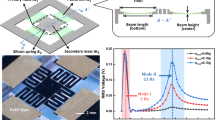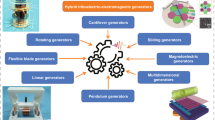Abstract
This paper describes a vibration energy harvester based on an origami mechanism through piezoelectric energy conversion. The device is capable of broadband energy harvesting from low frequency ambient vibrations. This design utilizes bistability inherent in the waterbomb base origami structure to increase the bandwidth of its frequency response. The folding along the crease pattern of the origami mechanism can facilitate large bending deformations of piezoelectric films to generate high electric power output. The compact size and light weight of the origami mechanism render it convenient for integration into various hosts subjected to vibrations. Performance of the origami mechanism is investigated under external excitations with various vibration magnitudes and acceleration levels. This work demonstrates a scheme of broadband vibration energy harvesting by integration of an origami structure with piezoelectric materials. A high fractional bandwidth of 40% is attained under a sinusoidal excitation with a peak acceleration of 0.1 g.















Similar content being viewed by others
References
Aitken, P. H. (1913). Some notes on the history of paper. Bibliographical Society.
Rogers, J., Huang, Y., Schmidt, O. G., & Gracias, D. H. (2016). Origami in MEMS and NEMS. MRS Bulletin, 41, 123–129.
Sorguc, A. G., Hagiwara, I., & Selcuk, S. A. (2009). Origamics in architecture: A medium of inquiry or design in architecture. METU Journal of the Faculty of Architecture, 26, 235–247.
Luan, L.-T., Thang, L.-D., Hung, N.-M., Nguyen, Q.-H., & Nguyen, H.-X. (2021). Optimal design of an origami-inspired kinetic façade by balancing composite motion optimization for improving daylight performance and energy efficiency. Energy, 219, 119557.
Song, Z., Ma, T., Tang, R., Cheng, Q., Wang, X., Krishnaraju, D., Panat, R., Chan, C. K., Yu, H., & Jiang, H. (2014). Origami lithium-ion batteries. Nature Communications, 5, 3140.
Morgan, J., Magleby, S. P., & Howell, L. L. (2016). An approach to designing origami-adapted aerospace mechanisms. Journal of Mechanical Design, 138, 052301.
Yellowhorse, A., & Howell, L. L. (2018). Deployable lenticular stiffeners for origami-inspired mechanisms. Mechanics Based Design of Structures and Machines, 46(5), 634–649.
Salerno, M., Zhang, K., Menciassi, A., & Dai, J.S. (2014) A novel 4-DOFs origami enabled, SMA actuated, robotic end-effector for minimally invasive surgery. In: Proceedings of the 2014 IEEE international conference on robotics & automation (ICRA), Hong Kong, China, May 31 - June 7 (pp. 2844–2849).
Suzuki, H., & Wood, R. J. (2020). Origami-inspired miniature manipulator for teleoperated microsurgery. Nature Machine Intelligence, 2, 437–446.
Faber, J. A., Arrieta, A. F., & Studart, A. R. (2018). Bioinspired spring origami. Science, 359, 1386–1391.
Treml, N., Gillman, A., Buskohl, P., & Vaia, R. (2018). Origami mechanologic. Proceedings of the National Academy of Sciences, 115(27), 6916–6921.
Miyashita, S., Guitron, S., Yoshida, K., Li, S., Damian, D.D., & Rus, D. (2016) Ingestible, controllable, and degradable origami robot for patching stomach wounds. In: Proceedings of the 2016 IEEE international conference on robotics and automation (ICRA), Stockholm, Sweden, May 16–21 (pp. 909–916).
Shigemune, H., Maeda, S., Hara, Y., Hosoya, N., & Hashimoto, S. (2016). Origami robot: A self-folding paper robot with an electrothermal actuator created by printing. IEEE/ASME Transactions on Mechatronics, 21, 2746–2754.
Belke, C. H., & Paik, J. (2017). Mori: A modular origami robot. IEEE/ASME Transactions on Mechatronics, 22, 2153–2164.
Thota, M., & Wang, K. W. (2018). Tunable waveguiding in origami phononic structures. Journal of Sound and Vibration, 430, 93–100.
Tao, K., Yi, H., Yang, Y., Tang, L., Yang, Z., Wu, J., Chang, H., & Yuan, W. (2020). Miura-origami-inspired electret/triboelectric power generator for wearable energy harvesting with water-proof capability. Microsystems & Nanoengineering, 6, 56.
Miranda, R., Babilio, E., Singh, N., Santos, F., & Fraternali, F. (2020). Mechanics of smart origami sunscreens with energy harvesting ability. Mechanics Research Communications, 105, 103503.
Li, S. (2017). Double-folding paper-based generator for mechanical energy harvesting. Frontiers of Optoelectronics, 10, 38–43.
Wang, Y., Wu, Y., Liu, Q., Wang, X., Cao, J., Cheng, G., Zhang, Z., Ding, J., & Li, K. (2020). Origami triboelectric nanogenerator with double-helical structure for environmental energy harvesting. Energy, 212, 118462.
Park, J. J., Won, P., & Ko, S. H. (2019). A Review on hierarchical origami and kirigami structure for engineering applications. International Journal of Precision Engineering and Manufacturing-Green Technology, 6, 147–161.
Hanna, B. H., Lund, J. M., Lang, R. J., Magleby, S. P., & Howell, L. L. (2014). Waterbomb base: a symmetric single-vertex bistable origami mechanism. Smart Materials and Structures, 23, 094009.
Silverberg, J. L., Na, J.-H., Evans, A. A., Liu, B., Hull, T. C., Santangelo, C. D., Lang, R. L., Hayward, R. C., & Cohen, I. (2015). Origami structures with a critical transition to bistability arising from hidden degrees of freedom. Nature Materials, 14, 389–393.
Pehrson, N.A., Magleby, S.P., & Howell, L.L. (2018) An origami-based thickness-accommodating bistable mechanism in monolithic thick-sheet materials. In: Proceedings of the 2018 international conference on reconfigurable mechanisms and robots (ReMAR), Delft, Netherlands, June 20–22. https://doi.org/10.1109/REMAR.2018.8449875.
Sharma, H., & Upadhyay, S. H. (2020). Geometric design and deployment behavior of origami inspired conical structures. Mechanics Based Design of Structures and Machines. https://doi.org/10.1080/15397734.2020.18337
Lechenault, F., & Adda-Bedia, M. (2015). Generic bistability in creased conical surfaces. Physics Review Letters, 115, 235501.
Waitukaitis, S., Menaut, R., Chen, G.-G., & van Hecke, M. (2015). Origami multistability: From single vertices to metasheets. Physical Review Letters, 114, 055503.
Yasuda, H., Chen, Z., & Yang, J. (2016). Multitransformable leaf-out origami with bistable behavior. Journal of Mechanisms and Robotics, 8, 031013.
Fang, H., Wang, K. W., & Li, S. (2017). Asymmetric energy barrier and mechanical diode effect from folding multi-stable stacked-origami. Extreme Mechanics Letters, 17, 7–15.
Filipov, E. T., & Redoutey, M. (2018). Mechanical characteristics of the bistable origami hypar. Extreme Mechanics Letters, 25, 16–26.
Johnson, D. R., Thota, M., Semperlotti, F., & Wang, K. W. (2013). On achieving high and adaptable dam** via a bistable oscillator. Smart Materials and Structures, 22, 115027.
Zhao, J., Sun, C., Kacem, N., Wang, H., Gao, R., Liu, P., & Huang, Y. (2018). A nonlinear resonant mass sensor with enhanced sensitivity and resolution incorporating compressed bistable beam. Journal of Applied Physics, 124, 164503.
Johnson, D. R., Harne, R. L., & Wang, K. W. (2014). A disturbance cancellation perspective on vibration control using a bistable snap-through attachment. Journal of Vibration and Acoustics, 136, 031006.
Shaw, A. D., Neild, S. A., Wagg, D. J., Weaver, P. M., & Carrella, A. (2013). A nonlinear spring mechanism incorporating a bistable composite plate for vibration isolation. Journal of Sound and Vibration, 332, 6265–6275.
Arrieta, A. F., Hagedorn, P., Erturk, A., & Inman, D. J. (2010). A piezoelectric bistable plate for nonlinear broadband energy harvesting. Applied Physics Letters, 97, 104102.
Lee, A. J., & Inman, D. J. (2018). A multifunctional bistable laminate: Snap-through morphing enabled by broadband energy harvesting. Journal of Intelligent Material Systems and Structures, 29, 2528–2543.
Toyabur, R. M., Salauddin, M., Cho, H., & Park, J. Y. (2018). A multimodal hybrid energy harvester based on piezoelectric-electromagnetic mechanisms for low-frequency ambient vibrations. Energy Conversion and Management, 168(2018), 454–466.
Zou, C., & Harne, R. L. (2017). Adaptive acoustic energy delivery to near and far fields using foldable, tessellated star transducers. Smart Materials and Structures, 26, 055021.
Badel, A., & Lefeuvre, E. (2016). Nonlinear conditioning circuits for piezoelectric energy harvesters. Nonlinearity in Energy Harvesting Systems, 25, 321–359.
Nayfeh, A. H., & Mook, D. T. (1979). Nonlinear oscillations. Wiley.
Thomson, W. T. (1988). Theory of vibration with applications (3rd ed.). Prentice-Hall Inc.
Fu, Y., Huang, M., Wu, R., Huang, F., Zhou, M., Chen, S., Wang, Q., & Li, Q. (2021). Piezoelectric vibration energy harvesting device based on water sloshing-inspired extensions. AIP Advances, 11, 065205.
Tsukamoto, T., Umino, Y., Shiomi, S., Yamada, K., & Suzuki, T. (2018). Bimorph piezoelectric vibration energy harvester with flexible 3D meshed-core structure for low frequency vibration. Science and Technology of Advanced Materials, 19, 660–668.
Han, M., Wang, H., Yang, Y., Liang, C., Bai, W., Yan, Z., Li, H., Xue, Y., Wang, X., Akar, B., Zhao, H., Luan, H., Lim, J., Kandela, I., Ameer, G. A., Zhang, Y., Huang, Y., & Rogers, J. A. (2019). Three-dimensional piezoelectric polymer microsystems for vibrational energy harvesting, robotic interfaces and biomedical implants. Nature Electronics, 2, 26–35.
Sohel, R. S. M., Toyabur, R. M., Salauddin, M., Sharma, S., Maharjan, P., Bhatta, T., Cho, H., Park, C., & Park, J. Y. (2021). Electrospun PVDF-TrFE/MXene nanofiber mat-based triboelectric nanogenerator for smart home appliances. ACS Applied Materials & Interfaces, 13, 4955–4967.
Acknowledgements
The computing facilities provided by the National Centerfor High-Performance Computing (NCHC) are greatly appreciated. The authors are also thankful for the financial support from the Ministry of Science and Technology, R.O.C., under Grant No. MOST 108-2221-E-005-058.
Author information
Authors and Affiliations
Corresponding author
Ethics declarations
Conflict of interest
On behalf of all authors, the corresponding author states that there is no conflict of interest.
Additional information
Publisher's Note
Springer Nature remains neutral with regard to jurisdictional claims in published maps and institutional affiliations.
Rights and permissions
About this article
Cite this article
Ngo, TH., Chi, IT., Chau, MQ. et al. An Energy Harvester Based on a Bistable Origami Mechanism. Int. J. Precis. Eng. Manuf. 23, 213–226 (2022). https://doi.org/10.1007/s12541-021-00614-x
Received:
Revised:
Accepted:
Published:
Issue Date:
DOI: https://doi.org/10.1007/s12541-021-00614-x




